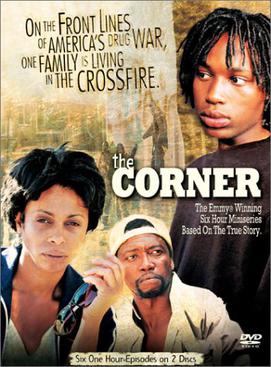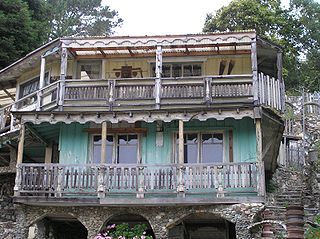
Only When I Laugh is a 1981 American comedy-drama film based on Neil Simon's 1970 play The Gingerbread Lady.

The Watts Towers, Towers of Simon Rodia, or Nuestro Pueblo are a collection of 17 interconnected sculptural towers, architectural structures, and individual sculptural features and mosaics within the site of the artist's original residential property in Watts, Los Angeles, California, United States. The entire site of towers, structures, sculptures, pavement and walls were designed and built solely by Sabato Rodia, an Italian immigrant construction worker and tile mason, over a period of 33 years from 1921 to 1954. The tallest of the towers is 99.5 feet (30.3 m). The work is an example of outsider art and Italian-American naïve art.

Watts is a neighborhood in southern Los Angeles, California. It is located within the South Los Angeles region, bordering the cities of Lynwood, Huntington Park and South Gate to the east and southeast, respectively, and the unincorporated community of Willowbrook to the south.

Adventures in Babysitting is a 1987 American teen comedy film written by David Simkins and directed by Chris Columbus in his directorial debut. It stars Elisabeth Shue, Keith Coogan, Anthony Rapp, and Maia Brewton, and features cameos by blues singer/guitarist Albert Collins and singer-songwriter Southside Johnny Lyon.

WQED is a PBS member television station in Pittsburgh, Pennsylvania, United States. Owned by WQED Multimedia, it is sister to public radio station WQED-FM (89.3). The two outlets share studios on Fifth Avenue near the Carnegie Mellon University campus and transmitter facilities near the campus of the University of Pittsburgh, both in the city's Oakland section.

Ollie Hopnoodle's Haven of Bliss is a 1988 American made-for-television comedy film written by Jean Shepherd and directed by Dick Bartlett, based on the 1968 short story by Shepherd. A satire of childhood recollections of annual family vacations, it follows the Parker family as they travel to a Michigan lakeside camp, the eponymous Haven. It was a co-production of The Disney Channel and PBS, and aired in that order, and was released on video.

The Alamo is a 1960 American epic historical war film about the 1836 Battle of the Alamo produced and directed by John Wayne and starring Wayne as Davy Crockett. The film also co-stars Richard Widmark as Jim Bowie and Laurence Harvey as William B. Travis, and features Frankie Avalon, Patrick Wayne, Linda Cristal, Joan O'Brien, Chill Wills, Joseph Calleia, Ken Curtis, Ruben Padilla as Santa Anna, and Richard Boone as Sam Houston. Shot in 70 mm Todd-AO by William H. Clothier, it was released by United Artists.
Rachel Ticotin Strauss is an American film and television actress. She has appeared in films such as Fort Apache, The Bronx, Total Recall, Falling Down, and Con Air. She has appeared in the NBC legal drama Law & Order: LA as Lt. Arleen Gonzales, and guest starred in the "Warriors" episode of Blue Bloods in 2013, appearing as "Carmen Castillo".
Mousey is a 1974 Canadian thriller action drama film directed by Daniel Petrie, and starring Kirk Douglas, Jean Seberg and John Vernon.

The Corner is a 2000 HBO drama television miniseries based on the nonfiction book The Corner: A Year in the Life of an Inner-City Neighborhood (1997) by David Simon and Ed Burns, and adapted for television by David Simon and David Mills. It premiered on HBO in the United States on April 16, 2000, and concluded its six-part run on May 21, 2000. The series was released on DVD on July 22, 2003. It won the Primetime Emmy Award for Outstanding Miniseries in 2000.

Nitt Witt Ridge is a house on two and a half acres in the coastal city of Cambria, California, United States. Artist and recluse Arthur "Art" Harold Beal (1896–1992) bought his hillside lot in 1928 and spent most of the next 50 years carving out the terraces with only a pick and shovel, creating his own "castle on a hill".

Christopher Columbus: The Discovery is a 1992 historical adventure film directed by John Glen. It was the last project developed by the father and son production team of Alexander and Ilya Salkind. The film follows events after the fall of the Emirate of Granada, and leads up to the voyage of Columbus to the New World in 1492.

Billy Rose's Jumbo is a 1962 American musical film released by Metro-Goldwyn-Mayer and starring Doris Day, Stephen Boyd, Jimmy Durante, and Martha Raye. An adaptation of the stage musical Jumbo produced by Billy Rose, the film was directed by Charles Walters, written by Sidney Sheldon, and featured Busby Berkeley's choreography. It was nominated for an Academy Award for the adaptation of its Rodgers and Hart score.

Tom Thumb is a 1958 British musical fantasy film produced and directed by George Pal, and released by MGM. The film, based on the fairy tale "Thumbling" by the Brothers Grimm, is about a tiny youth who manages to outwit two thieves determined to make a fortune from him.
Max, the 2000-Year-Old Mouse is a 1967 Canadian animated television series produced by Steve Krantz, which originally aired on Canadian Broadcast Corporation in Canada in 1967 and became popular in several parts of the world, most notably the United States, where it was syndicated on both local and PBS stations between 1969 and 1979, and also the United Kingdom, where it was repeated numerous times on the ITV network between its original transmission in 1969 and its last showing to date in 1992.
I Build the Tower is a feature-length documentary film depicting the life of Sabato Rodia, also known as Sam Rodia and Simon Rodia, the Italian immigrant who created the Watts Towers in South Los Angeles.

Even the Rain is a 2010 drama film directed by Icíar Bollaín and written by Paul Laverty.
Nicholas King was an American actor and horticulturist who was instrumental in preserving the Watts Towers.

The Eastern Star Home was a retirement home and convalescent facility in Los Angeles, California for the members of the Order of the Eastern Star, Master Masons and their female relatives. Built between 1931 and 1936, the home operated until the late 1990s when membership in the home had decreased precipitously to just 34 residents. "The retirement home moved to a new location, and the Order of the Eastern Star sold the property at Sunset Boulevard to Archer School for Girls."














